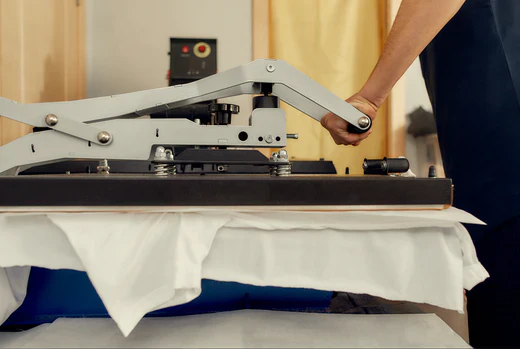
DTF Press is the most commonly used press for custom heat, primarily due to its ability to handle a wide range of jobs and produce high-quality results. heat transfers technology has evolved significantly, allowing for more intricate designs and vibrant colors.
Prepare your design.
GDS allows you to design your creation on a computer. Make sure your files are in CMYK color mode and have a high resolution (300 DPI) for best results. Make sure you reverse the design before printing when using a DTF press. You must complete this step because the substrate will mirror the transfer once you apply it.
Print the design.
Get your design printed on a DTF one-way transfer sheet and then put it in the right printer, which you’ve set up with sublimation ink. Print on high-quality DTF transfer film that is designed to be used with these inks. You need to fine-tune the printer settings appropriately for your transfer film (paper type, print quality). Print your design onto the film, and make sure it dries really well before you bake.
Apply Adhesive Powder
After printing and drying your design, apply the adhesive powder. This powder acts as a heat transfer to bond the ink with the substrate. Sprinkle the adhesive powder evenly over your print, ensuring that it covers all parts. To complete the process, apply the powder onto the film and utilize either a heat press or a curing oven, following the recommended settings provided by your ink manufacturer. This step helps to finalize the design before you start the implementation process.

Preheat the substrate.
Set the heat press to the recommended temperature for your transfer film and substrate type. The preheating drives off moisture and readies the surface for increased adhesion. After heating up your heat press, place the top down for a moment to ensure an even temperature across. .
Transfer the design.
Position the adhesive powder-printed flexo film onto the preheated substrate. Apply the design with a heat press, following manufacturer guidelines for temperature, pressure, and time. Use even pressure to make the design stick.
Peel and finish
After heat transfer, peel the film from the substrate while it is still warm. The procedure reveals the design, ensuring it adheres to the material. Before handling or washing the hot transferred image, please allow it to cool.
The process of carrying out successful heat transfers with a DTF press necessitates meticulous preparation, perfect printing, and implementation. However, with practice and precision in cutting out the pattern pieces, you can crank out professional-looking custom items in bulk.




